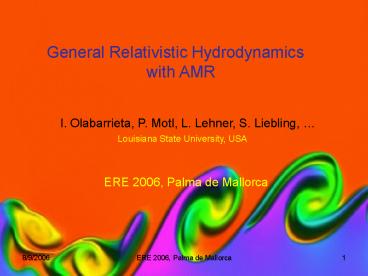General Relativistic Hydrodynamics PowerPoint PPT Presentation
1 / 11
Title: General Relativistic Hydrodynamics
1
General Relativistic Hydrodynamics
with AMR I. Olabarrieta, P. Motl,
L. Lehner, S. Liebling,
Louisiana State University, USA
ERE 2006,
Palma de Mallorca
2
- Outline
- Motivation.
- Infrastructure (HAD).
- Geometry.
- Hydro Treatment.
- Comparison between FD FV.
- AMR/Parallelization.
- Initial Data.
- Status and Whats Next?
3
Motivation The driving problem is the
study of neutron star binaries. Along
the way we want to revisit the head-on problem.
Comparison of Finite Difference (FD) and
Finite Volume (FV) methods. Accretion.
4
Infrastructure (HAD) Many different
projects are being developed using the
same Infrastructure Vacuum NR, special/general
(both background and dynamical) relativistic
hydro, Boson Star evolution (C. Palenzuela),
Critical Collapse, etc, Very
Modular. Parallelization
implemented. Allows for combined Finite
Difference and Finite Volume codes.
Different discretization stencils (orders) can be
used. AMR with different criteria
for refinement (shadow hierarchy).
5
Geometry For this particular project we
use the 1st order symmetric hyperbolic
formalism developed by Sarbach, Tiglio.
M. Tiglio, L. Lehner, D. Neilsen . Phys. Rev.
D70 (2004) 104018
Gauge Generalization of
Bona-Masso slicing. The implementation
makes use of the SBP. (Sasha told us it is
fashionable) This formalism has been
used with success in other setups ???
6
Hydrodynamics Using the experience of
J. Tohline, P. Motl from the evolution of compact
binaries in Newtonian gravity. For now ideal
EoS. GR ? Valencia Formalism
Densitization of the conservative
variables (produces a linearly stable
HC, see later)
Development history Flat space testing
(Blobs) Fully dynamical evolution (Blibs)
Single TOV (reproduce normal freq.)
Head-on collisions of TOVs. Rotating
neutron stars. Binaries !!!
7
Comparison between FV FD The use of
conservative methods has been crucial in the
evolution of compact binaries in Newtonian
physics in order to obtain long term evolutions.
(Tohline Motl)
Will we have the same situation to obtain
accurate fully dynamical GR simulations?
- Hydro code by Anderson, Nielsen,
- Hirschmann. HRSC using high order
- reconstruction.
- Not only hydro but GRMHD.
- Lets play pool
8
AMR Berger-Oliver algorithm has been
modified at the (artificial) interface
boundaries Tapering strategy or Xmas tree
structure. (L. Lehner et al. Class. Quant.
Grav. 23 (2006) S421-S446) What
happens in the FV case?? The FD defines the
refining regions. Example
Non-gravitating
relativistic rotor (M. Anderson)
9
Initial Data Time symmetric initial
data for now (K 0, v 0). Only have to solve
HC. Need to have a linearly stable
equation. Which can be obtained densitizing the
conservative variables (J. York, Sources of
Gravitational Radiation)
D Y ??? Yn 0, n lt 0.
In the case of
TOV initial data 1st the problem is solved in one
dimension and afterwards the matter fields are
extended To 3D. Once in we have the fields in 3D
the geometry is recalculated using a FAS
multigrid algorithm (with possible
perturbations)
10
Conclusions and Future Work Very
promising infrastructure to work on. It is
already showing a lot of progress for Boson Stars
(C. Palenzuela talk) and Finite Difference GRMHD,
on the way for FV hydro. We are in the
process of developing accurate gravitational wave
analysis tools. (Lehner, Liebling, etc, )
We plan to have rotating neutron stars. We need
ID. and Lets CRASH things together !!!!
11

